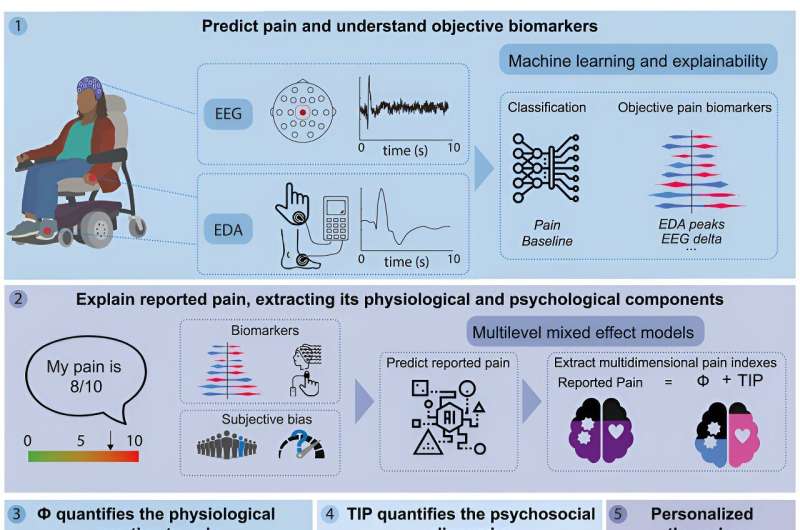This article has been reviewed according to Science X's editorial process and policies. Editors have highlighted the following attributes while ensuring the content's credibility:
fact-checked
peer-reviewed publication
trusted source
proofread
Separating the physical and psychosocial causes of pain

Not all pain is the same. Depending on the cause, it requires different therapies. A team led by ETH Zurich has now developed a method that enables physicians to better distinguish between physical and psychosocial pain.
Severe pain often has physical causes. But emotional, psychological and social factors can influence how we perceive and react to pain. "Pain is usually made up of a physical and a psychosocial component," explains Noemi Gozzi, a doctoral student at ETH Zurich.
Physicians do their best to take this into account in their treatment recommendations. So far, however, it's been difficult to clearly separate one component from the other. Physicians commonly rely on relatively simple approaches to determine pain and its intensity, based on the patient's subjective descriptions. This often leads to nonspecific therapies.
Opioid painkillers are still frequently used despite all their disadvantages: the undesirable side effects, diminishing effectiveness over time and the risk of becoming addicted to the medication—or even dying from an overdose.
Making treatment more individual
In recent years, Stanisa Raspopovic's group at ETH Zurich, of which Gozzi is a member, has worked with researchers at Balgrist University Hospital in Zurich to develop an approach that can clearly distinguish and quantify the physical and psychosocial components of pain. They have published their new method in the current issue of the journal Med. Raspopovic was Professor of Neuroengineering at ETH Zurich until recently.
"Our new approach should help physicians to assess patients' pain more individually and thus offer them more tailored personalized treatment in future," Raspopovic says. If the pain is primarily physical, doctors are likely to focus their treatment on the physical level, including the use of medications or physiotherapy.
If, on the other hand, psychosocial factors play a major role in the patient's experience of pain, it may be indicated to positively change the perception of pain with psychological or psychotherapeutic support.
Large dataset
To develop the new method, the researchers analyzed data from 118 volunteers—including people with chronic pain as well as healthy controls. The researchers asked the study participants in detail about their perception of pain and any psychosocial characteristics such as depression, anxiety and fatigue and how often they were in so much pain that they were unable to go to work. In addition, the researchers recorded how well the participants are able to distract themselves from pain, and the extent to which pain gets them brooding or makes them helpless and causes them to overestimate the pain.
The researchers used standardized measurements of sensations of spontaneous pain in order to compare the subjects' perception of pain. Participants were administered small, non-dangerous but painful pulses of heat on their skin.
To record the physical reaction of the pain, the researchers measured the study participants' brain activity using an electroencephalogram (EEG) and the electrical conductivity of the skin. The latter changes depending on how much someone is sweating and it is used to measure stress, pain and emotional arousals.
Finally, the extensive dataset included the diagnoses of the study participants, which were made by the researchers at Balgrist University Hospital.
Machine learning delivers precision medicine
Machine learning helped the researchers to analyze the large amount of data, clearly distinguish between the two pain components and develop a new index for each. The index for the physical component of pain indicates the extent to which the pain is caused by physical processes. The index for the psychosocial component indicates how strongly emotional and psychological factors intensify the pain. Finally, the scientists validated these two factors using the participants' comprehensive measurement data.
The new method, with its combination of measuring body signals, self-disclosure, computerized evaluation and the resulting two indices, is intended to help physicians treat pain.
"Our method enables physicians to precisely characterize the pain a particular person is suffering so they can better decide what kind of targeted treatment is needed," Gozzi says.
The researchers at ETH Zurich and Balgrist University Hospital are continuing this project; together with the Clinique romande de réadaptation in Sion and the spinal cord injury department of a hospital in Pietra Ligure, Italy. They're investigating the clinical relevance of the new method in a long-term study.
More information: Unravelling the physiological and psychosocial signatures of pain by machine learning, Med (2024). DOI: 10.1016/j.medj.2024.07.016. www.cell.com/med/fulltext/S2666-6340(24)00298-8


















